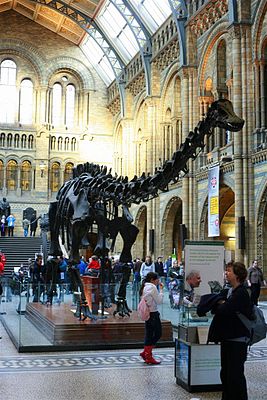Diplodocidae
| Diplodocidae | ||||||||||||
|---|---|---|---|---|---|---|---|---|---|---|---|---|

Skeletal reconstruction of Diplodocus in the Natural History Museum |
||||||||||||
| Temporal occurrence | ||||||||||||
| Upper Jurassic ( Kimmeridgian to Tithonian ) | ||||||||||||
| 157.3 to 145 million years | ||||||||||||
| Locations | ||||||||||||
| Systematics | ||||||||||||
|
||||||||||||
| Scientific name | ||||||||||||
| Diplodocidae | ||||||||||||
| Marsh , 1884 |
The Diplodocidae are a sauropod dinosaur taxon that can be found in fossil records in the Upper Jurassic . These included the well-known genera Diplodocus and Apatosaurus . Some genera may have belonged to the longest known dinosaurs, such as B. Supersaurus or Seismosaurus (the latter is often seen as a younger synonym of Diplodocus ). Sereno (1998) defined the Diplodocidae as a stem-based definition , which includes all taxa that are more closely related to Diplodocus than to Dicraeosaurus . Some of the skin prints of some Diplodocidae were first found by Stephen Czerkas in 1992 and were presumably the prints of a tail.
features
The representatives of the Diplodocidae were built relatively lightly due to their bone anatomy. The neck and tail were enormously elongated. Another feature is the long, low, sloping skull with pin-shaped teeth. The front legs were much shorter than the rear legs.
Systematics
External system
The Diplodocidae are mostly regarded as the sister taxon of the Dicraeosauridae . Both groups are common, such as B. of Harisson and colleagues (2004), as Fragellicaudata combined and together with the rebbachisauridae and basal genera group diplodocoidea .
Harrison et al. (2004):
| Diplodocoidea |
|
||||||||||||
|
|
Upchurch et al. (2004), however, consider the Fragellicaudata to be invalid and represent all three families as sister taxa.
Internal system
Lovelace and colleagues (2008) subdivide the Diplodocidae into the Apatosaurinae and the Diplodocinae . The following cladogram according to Tschopp et al. 2015 lists the genera valid after a recent revision of the Diplodocidae and shows their relationship:
| Diplodocidae |
|
||||||||||||||||||||||||||||||||||||||||||||||||||||||
|
|
Dyslocosaurus , known only by a few leg bones, is classified as Diplodocoidea incertae sedis . Another possible diplodocide is Dystrophaeus , whose fossil remains are highly fragmented, making its taxonomic classification very difficult.
Age and paleobiography
All fossils that can be safely assigned to the Diplodocidae come from the Kimmeridgian and Tithonian ( Upper Jurassic ). Finds come mainly from the North American Morrison Formation . Only Dinheirosaurus is known from Europe . An African diplodocide is Tornieria .
Individual evidence
- ^ Gregory S. Paul : The Princeton Field Guide To Dinosaurs. Princeton University Press, Princeton NJ et al. 2010, ISBN 978-0-691-13720-9 , pp. 189-194, online .
- ↑ a b c Paul Sereno : Diplodocidae. (No longer available online.) In: Taxon Search. Archived from the original on August 14, 2014 ; accessed on August 13, 2014 . Info: The archive link was inserted automatically and has not yet been checked. Please check the original and archive link according to the instructions and then remove this notice.
- ↑ Stephen A. Czerkas: The new look of sauropods. In: Journal of Vertebrate Paleontology. Vol. 13, Supplement to No. 3 = Abstracts of Papers. Fifty-Third Annual Meeting Society of Vertebrate Paleontology. New Mexico Museum of Natural History and Science, Albuquerque, New Mexico. October 13-16 1993 , ISSN 0272-4634 , 1993, p. 26A.
- ^ John S. McIntosh: Sauropoda. In: David B. Weishampel , Peter Dodson , Halszka Osmólska (eds.): The Dinosauria . University of California Press, Berkeley CA et al. 1990, ISBN 0-520-06726-6 , pp. 345-401.
- ↑ a b Jerald D. Harris, Peter Dodson: A new diplodocoid sauropod dinosaur from the Upper Jurassic Morrison Formation of Montana, USA. In: Acta Palaeontologica Polonica. Vol. 49, No. 2, ISSN 0567-7920 , pp. 197-210, online .
- ^ Paul Upchurch , Paul M. Barrett , Peter Dodson: Sauropoda. In: David B. Weishampel, Peter Dodson, Halszka Osmólska (eds.): The Dinosauria . 2nd edition. University of California Press, Berkeley CA et al. 2004, ISBN 0-520-24209-2 , pp. 259-324.
- ↑ David M. Lovelace, Scott A. Hartman, William R. Wahl: Morphology of a specimen of Supersaurus (Dinosauria, Sauropoda) from the Morrison Formation of Wyoming, and a re-evaluation of diplodocid phylogeny. In: Arquivos do Museu Nacional. Vol. 65, No. 4, 2007, ISSN 0365-4508 , pp. 527-544, digitized version (PDF; 21.68 MB) ( Memento of the original from July 30, 2014 in the Internet Archive ) Info: The archive link was inserted automatically and not yet checked. Please check the original and archive link according to the instructions and then remove this notice. .
- ↑ a b Emanuel Tschopp, Octávio Mateus, Roger BJ Benson. A specimen-level phylogenetic analysis and taxonomic revision of Diplodocidae (Dinosauria, Sauropoda). PeerJ , 2015; 3: e857 DOI: 10.7717 / peerj.857
- ^ The Morrison Formation ( April 10, 2005 memento on the Internet Archive ) , from the Dinosaur Encyclopedia, including dates of major sites.
- ↑ Dinheirosaurus ( Memento from September 22, 2009 in the Internet Archive )


